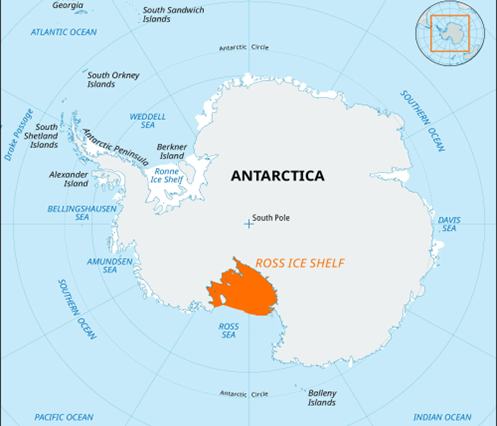- Courses
- GS Full Course 1 Year
- GS Full Course 2 Year
- GS Full Course 3 Year
- GS Full Course Till Selection
- MEP (Mains Enrichment Programme) Data, Facts
- Essay Target – 150+ Marks
- Online Program
- GS Recorded Course
- NCERT- First Ladder
- Polity
- Geography
- Economy
- Ancient, Medieval and Art & Culture AMAC
- Modern India, Post Independence & World History
- Environment
- Governance
- Science & Technology
- International Relations and Internal Security
- Disaster Management
- Ethics
- Current Affairs
- Indian Society and Social Issue
- CSAT
- 5 LAYERED ARJUNA Mentorship
- Public Administration Optional
- ABOUT US
- OUR TOPPERS
- TEST SERIES
- FREE STUDY MATERIAL
- VIDEOS
- CONTACT US
Antarctica's France-Sized Ice Shelf Makes Daily Jumps
Antarctica's France-Sized Ice Shelf Makes Daily Jumps
27-04-2024
Researchers have discovered a surprising phenomenon in Antarctica: the giant Ross Ice Shelf, approximately the size of France, moves several centimeters once or twice a day.
- This motion is initiated by the Whillans Ice Stream, a fast-flowing river of ice that sometimes becomes stuck and then moves forward.
About Ross Ice Shelf:
- Located in the Ross Sea, this massive ice shelf is
 the largest in Antarctica and the largest floating ice store in the world, covering an area approximately the size of France.
the largest in Antarctica and the largest floating ice store in the world, covering an area approximately the size of France. - Only 10% of the ice shelf is visible, with the vast majority submerged several hundred meters below the surface.
- The thickness of the ice shelf ranges from about 100 meters to several hundred metres.
- Formed by the accumulation and compaction of snow over time, the Ross Ice Shelf is constantly fed by ice from glaciers draining from both the East and West Antarctic Ice Sheets.
- As new ice is added, existing ice is removed through melting at the base and ice calving at the front.
- The Ross Ice Shelf plays an important role in stabilizing the Antarctic ice sheet, supporting constantly moving ice on the land surface.
Ross Sea:
- A vast bay located just 320 kilometers from the South Pole, the Ross Sea is remote and positioned south and slightly east of New Zealand.
- The largest polar marine ecosystem in the world, the Ross Sea is relatively shallow, covering an area of approximately 960,000 square kilometers.
- A large portion of the sea is covered by the Ross Ice Shelf, which influences its circulation and ecosystem.
- The Ross Sea is strongly influenced by the coastal East-Wind Drift, which sets up a vast clockwise gyre accompanied by deep water upwelling.
- Notable as the first protected area in Antarctica, the Ross Sea is home to most of the world's penguins and many species of whales.
Must Check: Best IAS Coaching In Delhi
India’s EV Mission: Progress Delayed, Not Denied
India’s EV Mission: Progress Delayed, Not Denied


